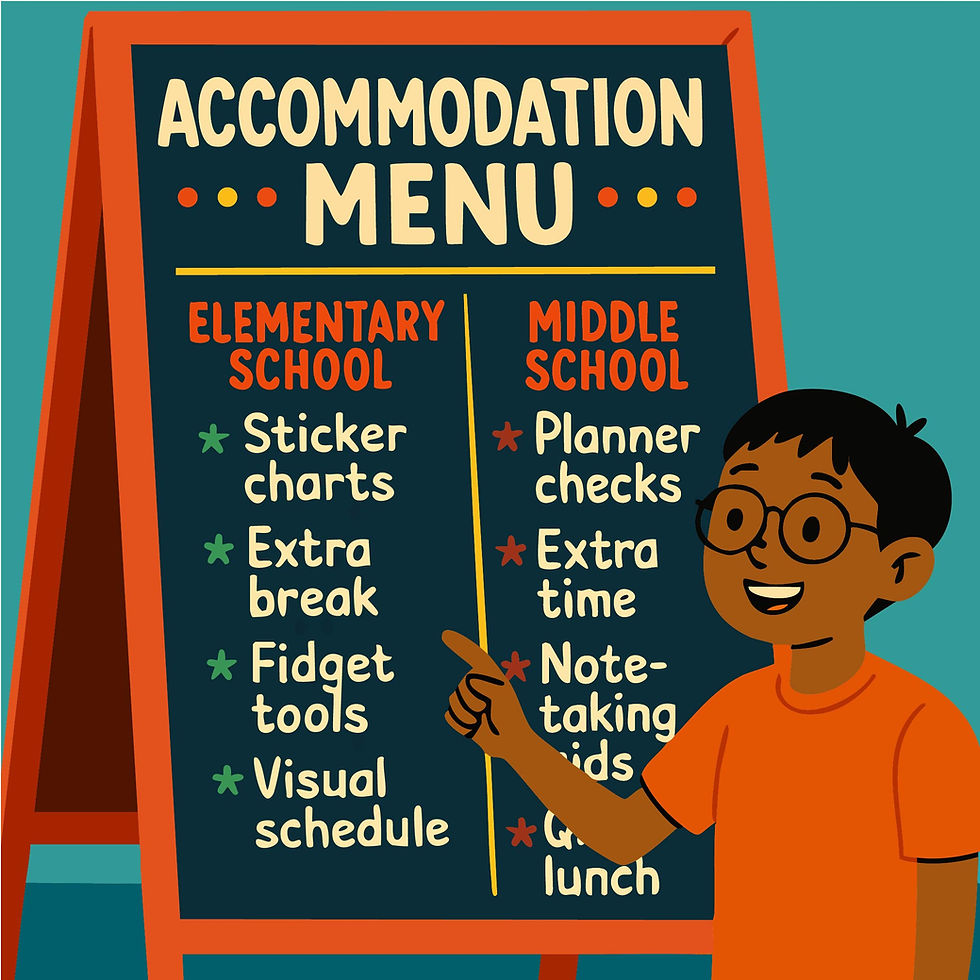504 Plan? More Like 5,000 Emails and 4 Meltdowns Later — Part 3 of 3
- Tara Gentile
- Aug 11
- 7 min read
THE ACTION PLAN - The brutally honest ADHD parenting guide to what a 504 Plan actually is, why your neurodivergent kid needs one, and how to build it — with humor, grit, and real-life examples.
Welcome back! In Part 1 - The Foundation, we covered what a 504 Plan is, why most ND kids start here, and how it compares to an IEP. In Part 2 - The Grade-Level Playbook, we tackled the copy/paste accommodation lists for elementary and middle school.
Now it’s time for the final round — high school accommodations, step-by-step instructions for requesting a 504 Plan, what to do if the school drags its feet, and the ultimate screenshot-worthy advocacy checklist.
If you missed Part 1 or Part 2 , start there so you’re not playing catch-up. If you’re caught up, grab some caffeine — we’re about to tackle the SAT-panic era.

HIGH SCHOOL: Executive Dysfunction with a GPA
Here’s where things get real. Suddenly, your neurodivergent kid is expected to:
Manage 6+ classes
Self-advocate like a seasoned lawyer
“Just turn it in on time”
Understand the consequences of a missed assignment three weeks later
Spoiler alert: they can’t. And they shouldn’t have to — yet.
Your job? Build a 504 Plan that:
Supports independence, but scaffolds it
Protects mental health, not just grades
Still holds teachers accountable — even when they assume “he seems fine”
Attention & Focus
Allow fidget tools — and make sure staff knows this isn’t a toy; it’s a coping strategy that keeps them in the room mentally.
Prompt for movement breaks — especially during block periods or double-length tests, because sitting still for 90 minutes is an Olympic event.
Redirection when off-task — ideally subtle, not shouted from across the room like a carnival barker.
Preferential seating near instruction and away from distractions — not “back of the room next to the kid filming TikToks.”
Instruction & Academic Access
Directions given both verbally and in writing — because executive function needs redundancy, not “hope you remembered it.”
Access to recorded lessons when available, or permission to record classes — replaying is better than relying on Swiss cheese memory.
Extra time or extra class period on assignments (not just tests!) — clarify that extended time covers projects, papers, and homework, not just scantrons.
Clear study guides or outlines before tests — “the review is in the notes” is not a plan when their notes look like cryptic doodles.
Reduced workload when appropriate — 30 math problems = meltdown; 10 solid ones = mastery without the tears.
Tests & Assessments
Time-and-a-half on all tests and quizzes — brains need processing time, not speed trials.
One test retake per assessment — to be arranged with the teacher and completed within the same week; sometimes the second try is when it clicks.
Open-note or take-home tests when appropriate — determined by teacher, but written into the plan so it’s not forgotten.
Alternate test settings — like support centers, not classrooms full of pencil tappers and whisperers.
Planning & Organization
Use of a digital planner/calendar — with school support to set it up and maintain it (because “just download the app” is not enough).
Check-ins with support staff, counselor, or case manager to review work completion and stress levels — accountability plus emotional temperature checks.
Access to assignment portals and teacher feedback in real time — transparency keeps spiraling in check.
Emotional Regulation & Overload Prevention
Permission to take short breaks or use a “cool down” space if overwhelmed — without being marked truant or disruptive.
Mental health days — even if informal, coded as excused absences for burnout or overload.
Alternative assignments when emotional dysregulation or health issues derail participation — keeping grades from tanking while they recover.
Why it matters?
In high school, there’s this magical belief that all the supports should vanish because your kid “needs to be ready for adulthood.”
Cool story. But your kid is 14, can’t find their socks, and is one late assignment away from an existential crisis. This is not the moment to scale back — it’s the time to reframe support as strategy.
The 504 Plan is not a crutch. It’s a toolkit.
You’ve got your grade-level game plan. Now here’s how to actually get it in place without sending 47 unanswered emails into the void.
How to Request a 504 Plan (and What to Do When the School Tries to Ghost You)
You’ve got the legal info. You know the diagnosis. You’ve got the grade-level wish list. Now let’s talk about actually getting a 504 Plan in place — without losing your mind or filing 37 emails into the abyss of “no response yet.”
Step 1: Request the Meeting (In Writing. Always in Writing.)
The process starts with a formal request for a 504 meeting, which can be submitted by a parent, teacher, or school staff. But let’s be real — it’s almost always the parent making the first move.
Here’s a simple script you can copy-paste into an email:
Subject: Request for 504 Plan Meeting
Dear [Principal/Counselor/504 Coordinator],
I am requesting a 504 Plan meeting for my child, [Full Name], who is a [Grade] student at [School]. Due to [brief explanation — ADHD, autism, anxiety, etc.], my child requires accommodations to access their education in a fair and equitable manner.
Please consider this a formal written request to begin the process as outlined under Section 504 of the Rehabilitation Act. I look forward to discussing next steps.
Thank you,[Your Name]
Keep a copy. Save the date. Screenshot it. Tattoo it on your forearm if you have to. Written requests start the legal clock.
Step 2: The School Evaluates (Sort of)
They’ll gather grades, teacher reports, testing (if any), medical records — and decide whether your child qualifies. If you’ve got a diagnosis from a licensed professional, you’re already in a strong position.
Reminder: Your child doesn’t need to be failing to qualify. The law requires a limitation in a major life activity (like concentrating, learning, or organizing) — not tanking their GPA.
What you can (and should) provide:
Private evaluations
Doctor’s notes
Past IEPs or 504s (if applicable)
A short, bullet-point summary of how school impacts your child’s daily functioning
Step 3: The 504 Meeting (Pack Snacks. And Receipts.)
Once eligibility is confirmed, you’ll meet with teachers, admin, and staff to hammer out the plan.
Meeting survival tips:
Bring a list of non-negotiables (steal from the earlier grade-level sections).
Bring a “How My Kid Learns” breakdown — strengths, needs, and behaviors. (Mine was 5 pages because I wanted them to see my son as a whole person, not just a diagnosis.)
Stay calm. But firm. But calm. But also bring caffeine.
Ask for specific accommodations — “extra help” is too vague.
Don’t leave without a signed plan or a clear follow-up date.
If someone says, “We don’t do that,” smile and reply:
“Actually, under Section 504, the school is required to provide accommodations tailored to the student’s individual needs.”
You don’t have to be aggressive — but you do have to be unshakable.
Step 4: Follow Up Like It’s Your Job (Because It Kinda Is)
Once the plan is in place:
Email teachers at the start of each semester with a 1-page summary.
Check in monthly with your kid and counselor.
If something’s not working? Request a 504 review meeting — you’re allowed to update the plan anytime.
What If They Push Back?
If the school delays, downplays, or denies support:
Put everything in writing.
Request meeting notes and copies of all documents.
Escalate to district-level staff if needed.
File a formal complaint through the district’s Section 504 Coordinator or the Office for Civil Rights (OCR).
Bonus move: Start CC’ing people. The moment someone from the district office shows up in the thread, watch how quickly things start moving.
Final Thoughts from a Mom Who Owns a Binder Tabbed Like a Law Library
You’re not imagining it — the system is overwhelming on purpose. But you’re not asking for special treatment; you’re asking for fair access.
A 504 Plan won’t erase challenges, but it will acknowledge them and build around them. It exists to bridge the gap between what your kid knows and what they can do in a neurotypical system.
Whether you’re in the sticker-chart years or the SAT-panic era, keep advocating, keep asking, and keep emailing until you get a reply.
Your kid’s brain is already doing the heavy lifting. The 504 is there to lighten the rest.
—Tara
Accommodation Architect, Professional School-Form Translator
📌 504 Request Checklist (Screenshot This)
Before you start:
— Gather the diagnosis (or start the school’s evaluation process)
— Collect any private evals, doctor’s notes, past IEP/504 plans
— Jot down specific struggles + accommodations you want
Step 1: Request in Writing Email the principal, counselor, or 504 coordinator Keep a copy — written requests start the legal clock
Step 2: Provide Documentation
— Share evaluations, medical notes, teacher reports
— Emphasize how challenges impact major life activities (not just grades)
Step 3: 504 Meeting
— Bring your list of non-negotiables (from this blog)
— Share a “How My Kid Learns” breakdown
— Stay calm, be firm, bring caffeine
— Leave with a signed plan or a follow-up date
Step 4: Follow Up
— Email teachers a 1-page plan summary each semester
— Monthly check-ins with your kid + counselor
— Request a review if something isn’t working
If they push back:
— Keep everything in writing
— CC district staff
— Escalate to the Section 504 Coordinator or OCR
Remember: You’re not asking for special treatment — you’re asking for fair access.




Comments